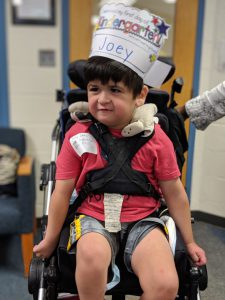
It’s here! Today – the day we’ve been talking about for months now – is finally here. Joey started kindergarten. I haven’t gotten to see him yet to hear about it, but what I know from this picture tells me so much about what he thought about it.
Here is a summary of all the steps we took to get ready for today. We hope these ideas will help others on their journey for preparing their own children for school.
~~ ~~ ~~
As we got Joey ready for kindergarten, we tried to think through anything that could be a stumbling block for his experience. While some of these things we can’t help, we’ve realized there are some ways we can support him.
Introducing him to his classmates:
We made a book that introduces Joey to his new classmates. It shares who he is and what he likes – just like a typical kindergartener. The book also shares about Joey’s communication device, and how he will communicate differently with his computer. It also discusses some difficulties he has with the device, and how easy it is to say the wrong word, even when he knows the right answer. Finally, it gives ideas for how his classmates can interact with him throughout the day – at recess, at lunch, in the classroom, and in music class.
Our hope with the book is that the teacher can read it to the class and open conversation with them about Joey’s abilities and communication. This will let his classmates ask questions and understand Joey better, so that they feel comfortable playing with him and treating him like a member of their class, instead of someone they don’t know how to interact with.
Joey’s family put together a short video of Joey to show to his classmates. The video’s bright, engaging colors paired with pictures of Joey, add another opportunity to show the similarities between Joey and his peers. It also gives a visual example of how Joey’s body moves when he gets excited. This will prepare his friends for Joey’s sudden, uncontrollable movements so that when they see it for the first time in person they are not scared.
Introducing Joey to school rules:
After watching Joey in different group settings, his family realized that one aspect of kindergarten that may prove to be confusing is the need to be quiet during particular times of the day. This is the opposite of what we’ve been encouraging for so long, because at home we want Joey to talk and communicate as much as possible. Now it’s time to learn that different settings and situations require different sets of behaviors.
Joey’s grandmother put together a beautiful social story to explain “quiet time” to Joey. We have been reading the story for the past month, and practicing talking times and quiet times. She included a symbol in the book to represent quiet time, and we are able to use the symbol outside of the book to signify when it is time to be quiet. Joey’s teachers will be able to use the symbol at school as well, to give him a visual representation of when he will need to sit quietly, and when he can talk.
Because we do want Joey to participate as much as possible in his classroom, his grandmother also got him a switch connected to a light. The light is on a foam hand attached to the top of his wheelchair, so that when Joey wants to answer a question, he can use the switch to “raise his hand”, instead of concentrating on the motor planning required to raise his hand slightly (which may not be obvious to the teacher.)
Helping Generate Inclusive Ideas for Joey’s Teachers
Joey’s team has also been brainstorming ways to help Joey be able to interact with his school environment as inclusively as possible. Recess always presents a problem for children with motor difficulties, because they often find that their peers have run to the top of the playground and they are unable to follow.
We want recess to be a fun time for Joey, and not a time when he has to sit and watch other children play. To help, we’ve created a list of ideas to share with his teachers about what he could do at recess instead. Ideas include:
- Having music for a dance party by Joey’s chair
- Giving Joey a bubble wand that he can wave and create bubbles for his friends
- Tying a ball or balloon to a tree or piece of playground equipment and encouraging Joey and peers to use it as a type of tetherball game.
- Creating a ramp with cardboard that goes from Joey’s tray to the ground. Joey and his friends can roll small toy cars down the ramp.


